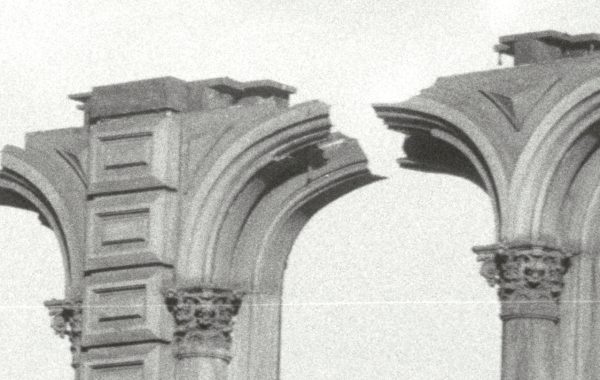This is Queens Plaza, a traffic nightmare where two of the largest streets in the borough (Queens Boulevard and Northern Boulevard) merge to form the approach to the 59th Street/Queensboro Bridge. On top of that traffic is an elevated station for the 7 and N subway lines; below it is a subway station for the E, F, M, and R lines. The elevated steel structure here is the east end of the elevated station. There are actually multiple scars in this photo, but there’s a close up of one below for reference. They all show the same thing: there used to be steel beams running into the columns from the left, and they’ve been burned off.

The history of the New York subways system is tangled – both figuratively and literally – but there are definable eras. Heavy rail transit (as opposed to streetcars) in the city began with railroads (the New York and Harlem Railroad was first), then came the elevated lines, then the privately-owned IRT subway, then the privately-owned Dual System (IRT and BRT/BMT), then the city-owned IND, and then merger. That history has to be placed in the context of other events. The els were largely built before consolidation in 1898 (before New York swallowed its neighbors), and the IRT began construction just after. Queens, which had not played a large part in planning for the city before 1898, suddenly needed transportation in general and mass transit to encourage development. Part of the response was the construction of the Queensboro Bridge (1903-1909) to provide a direct link to Manhattan, part was the connection of the Long Island Railroad to Manhattan (as part of the construction of Penn Station, 1902-1910), and part was the planning of the first subway connections in Queens within the Dual Systems. There were two lines planned, starting around 1913 – one heading from the Queens Plaza area north, parallel to the East River, through Long Island City and Astoria, and one heading east along Queens Boulevard and Roosevelt Avenue, first to Corona and eventually to Flushing. (In modern terms, the N line and the 7 line, respectively.) The line to the north got to Queens through a new tunnel on the line of Manhattan’s 60th Street, just north of the bridge; the line to the east got to Queens through a tunnel further south started in 1892 for a streetcar scheme, abandoned in 1896, and then bought by the IRT company in 1905.
The scheme could have been simple: two companies building an extended subway system, each with a tunnel to Queens, and two lines. Except that no one was sure which line would be more profitable, so both companies wanted to be able to run trains on both lines, and the companies used different sized trains (the IRT cars are, to this day, narrower than the other subways) so they could share tracks but not platforms. The solution was to use the Queensboro Plaza station as a transfer: the IRT trains came from the southern tunnel, stopped at the station, and could then go onto either branch, while the BRT trains came in from the northern tunnel and turned around at the statism, with BRT shuttle services using IRT-sized trains heading north and east from there. (The BRT was reorganized and renamed in 1923 to the more familiar BMT.) One more complication: the IRT had bought the elevated trains in Manhattan and decided to run a branch of the Second Avenue el over the Queensboro Bridge to the transfer station and beyond. The track layout at the station was a mess:

The track diagram gives the answer to the original question. After the Second Avenue el was demolished, it was much simpler to run all the BMT trains from the northern (60th Street) tunnel to Astoria and to run all the IRT trains from the southern tunnel to Flushing. The need for four platforms and eight tracks was eliminated, as each line needed one track in each direction (four tracks total) and that could be handled at the two levels of southern platform (the ones marked IRT in the diagram). The northern platforms and tracks were demolished, leaving the scars on the columns that had been between the platforms and are now at the northern face of the station.
This story is already running a bit long, so I’ll finish tomorrow.




You must be logged in to post a comment.